Menus
- The first Metzeler bigomme
- Everything changes, but you can’t see it ….
- Variable voltages
- Let’s go into detail !
- On track !
- In summary
- Available sizes:
- Longevity tests and biker reviews to come on the long-term tire test.
The first Metzeler bigomme
Born 2 years ago, the Roadtec Z8 is being upgraded under the impetus…. competition ! To explain the details to us and make us discover the substance of it, Metzeler invited us to the watered track of Vizzola (Milan). On site we simply discovered the first Metzeler bi-eraser !
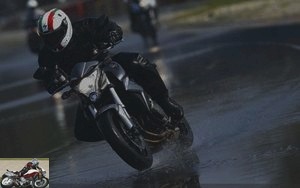
The GT sport tire niche is a major issue for manufacturers. Indeed, this fitment represents a very strong market share, since this type of tire is suitable for a road vehicle, a GT, a roadster as well as a sports car, if it does not do a circuit. In fact, there is no question of missing or having a product that is not up to par. However, while there are no bad tires among the major specialists, the fierce competition between them leads to an improvement in performance that is as spectacular as it is rapid. It is forbidden to keep both feet in the same hoof! To stay in the spotlight, excellence is essential. Spurred on by the arrival of the Michelin Pilot Rod 3, particularly excellent in the rain, and the Dunlop Roadsmart II, Metzeler technicians got back to work…. Let’s be clear, the Z8 hadn’t gotten bad, it was just that the competition had taken a hell of a leap forward.
Everything changes, but you can’t see it ….
For a novice, the new Z8 remains "round and black", but more seriously, it retains its elegant "pi" sculptures, the famous Greek letter, also present on the Sportec M5 tire. Externally, its appearance remains unchanged. This is probably what made marketing people keep the same name. However, under this unchanged appearance, Metzeler hides a small revolution since the rear Z8 is the first twin compound marketed by the German-Italian manufacturer (Pirelli and Metzeler are part of the same group).
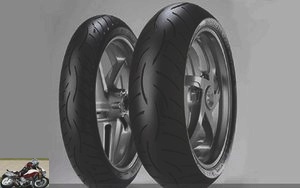
The "Interact" technology dear to Metzeler, however, remains present, it is added to the two-compound process, to make it more linear.
Explanations…

Variable voltages
As a reminder, Interact technology is based on a process for prestressing the 120 steel cables distributed in the tire carcass. In doing so, areas of different stiffness are obtained which allow the rubber to work to a greater or lesser extent. These mobility zones determine the ability of the rubber to heat up and to deform, which ultimately amounts to having several types of mixtures on the surface of the tire…. However, the process seems to have its limits since, despite everything, the manufacturer is switching to the “real” dual compound. However, by keeping the Interact process, Metzeler smooths the transition between the hard rubber, in the center of the tread, and the soft rubber on the ends. The new Z8 thus retains 3 tension zones, but they have been adapted to the different types of rubber.
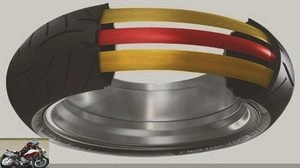
High center cable tensions reduce movement, promoting longevity and stability of the ground contact area (shown in red).
On the other hand, the low tension of the cables on the outside favors the absorption of energy thanks to their greater flexibility. In these areas (in yellow) the rubber which heats up, becomes softer and offers better grip when cornering. Remember that, the hard rubber ensures the longevity of the tire and avoids its square wear for those who drive a lot on the motorway, while the soft rubber provides good grip when cornering..
By playing on the variations in tension, Metzeler manages to soften the transition between the two compounds. This can prevent uneven wear, or even a "step" between the two compounds over the miles, or a lack of stability of the tire. These faults are however more noticeable at the front than at the rear. But precisely, the Roadtec Z8 is a dual compound rear and single compound front. Indeed, at the front, the problem of wear is less crucial. The main thing here is to offer good confidence and a high level of grip. So a relatively soft rubber will do the trick on the whole tire, so that in all circumstances, the pilot never has the feeling of losing the front … and even more than the feeling, that he does not. never lose the front at all !
Let’s go into detail !
Very concretely, the rubber distribution is done in three zones 40%, 20%, 40%, the central part being about 45 mm wide while the shoulders are 88 mm (depending on the size of the tire). In the center the new mixture contains 70% silica while on the shoulders it is 100% loaded, which improves grip on wet surfaces. To ensure good homogeneity of the mixes, Metzeler uses nanotechnologies, which also guarantees an optimal heating time and good grip on dry roads..
Finally, Metzeler paid attention to tire wear. The objective was indeed to have good behavior over a wide spectrum of temperatures, but above all to maintain it throughout the life of the tire. At the front, there is a mixture derived from that used for the rear central part. It therefore now contains 100% silica too, against 50% silica / 50% carbon black previously.
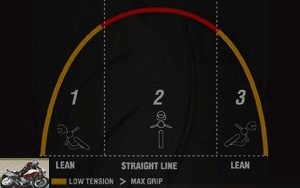
On track !
Enough theory, let’s get down to practice, and hit the wet track at the Vizzola test center. As you can see, it is not only the track that is wet, the pilot too! The rain suit was therefore appropriate, some colleagues returned with 2 kilos more in their luggage on the way back, ie the amount of water absorbed by their leather suit…. The beginnings on the track are therefore particularly impressive, so much we take full face and the rest. You have to go beyond your apprehension to focus on steering and the available grip. Over the laps, we free ourselves and finally if the experience remains impressive, it is no longer because of the presence of water, but indeed because of the grip available! "I have never driven so fast in the wet" said a colleague. In fact, this excellent result is certainly due to the quality of the tires, but also to that of the bitumen which has just been redone. Cornering speeds are very high and braking distances particularly short.

Over the laps, we get caught up in the game, as if the track was dry … or almost! The exercise turns out to be very different from the one we have been able to practice at Michelin or at Dunlop, whose wet track offers the same level of grip as a bar of soap on the edge of a sink. On the other hand, it is also in these extreme sliding conditions that we appreciated the tires of the said brands..
In the exceptional conditions of Vizzola, the Roadtec Z8 M / O proves to be safe and precise, very neutral: it goes where the eye falls. The acceleration capacities are very high, but let’s recognize that it is more difficult to tell the difference than on a slippery track which exacerbates the sensations..
We had 6 different motorcycles at our disposal to judge the new Z8: Honda Hornet and CBR 1000 R, BMW R 1200 RT, Triumph Tiger 1050 and Kawa Versys 1000. The sixth was a Bandit 1250 on which we were able to experiment with competing tires: Michelin Pilot Road 3, Dunlop Roadsmart 2 and Bridgestone BT 23.
It is clear that if we manage to observe nuances between the different manufacturers, the level of excellence achieved leaves one stunned with admiration. When we have known the tires of the 80s on wet roads, how can we not be ecstatic about the potential of modern tires, which in addition to an incomparable level of grip are also and above all much more considerate when stalling! Stalls precisely, we will indeed see a few, but always from the rear, when passing through ditches or on very strong acceleration. It’s more obvious with the BT 23 when accelerating, but you really have to go hard to get it to stall gradually here. On the other hand, its front is royal and sharper than the Roadtec. Also keen on the Michelin, also extremely safe, against a rounder Roadsmart 2, which finds its limits a little earlier than the Michelin and Metzeler, but later than the Bridgestone, especially under acceleration..

To locate the differences, we asked Salvo Pesini about the time difference achieved with the Z8 M / O and a real racing rain tire. Verdict "of the fastest grandfather in Italy": 34.5 sec per lap with the Z8, against 33.8 with a Pirelli rain used in SBK and mounted on a Honda CBR 1000 RR, or 7/10 of a sec on a 1 km track. Which would amount to a good 2 full seconds on a 2-minute lap. Difficult to really quantify the differences for us so…
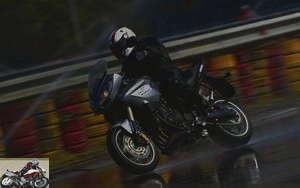
In summary
If because of the too new bitumen, it was difficult for us to differentiate between the protagonists, we can take as a complementary reference the tests of our colleague “Das Motorrad” submitted by Metzeler. We actually discover that on a wet track, the Z8 M / O has risen to the level of the Michelin PR3 in the rain and even exceeds it very slightly, thus widening an even greater gap with the Roadsmart 2. Metzeler has therefore reached its objective, because according to our colleague, this improvement was not made to the detriment of the overall wear, nor of the behavior on dry tracks, nor even of the good performance over time. A faultless performance which earned him the victory in the Motorrad, MCN and Moto IT 2012 comparisons! On our side, we had already been able to appreciate the excellent behavior of the old Z8 on the dry Sicilian roads..
Only the wet was missing. That’s done. There is no doubt that the competition is already putting in coal, no forgiveness, rather silica for that matter. !
Strong points
- Have your rain suit
- Excellent handling on wet runways
- Braking distances
- Unanimous press results
- Unchanged rate.
Weak points
- Some dimensions that are not available in the new M / O version
- The test track offering too much grip to really feel the gaps
- To be watered copiously
Recommended price: 250 € the front / rear set in 120/180 ZR 17.
Available sizes:
- AV
120/70 ZR 17 - AR
180/55 ZR 17
190/50 ZR 17
190/55 ZR 17

Longevity tests and biker reviews to come on the long-term tire test.
Related articles
-
Metzeler Sportec M7 RR tire test
A champion tire in the rain Eager to have us try out his hypersport tire in sunny Almeria, Metzeler had planned a “spin” program based on S 1000 RR 2015….
-
It’s on the private test circuit located in Mireval, near Montpellier, which Dunlop presented at the start of the week its new dual compound tire. Called…
-
Pirelli Diablo Rosso III tire test
A single-compound front hypersport-road tire, dual rear compound Road and circuit tire test, in – almost – dry, wet and cold conditions Pirelli renews…
-
Operation Seduction II The journalists troop follow in the footsteps of opener Dunlop and leave Ajaccio on a 4-lane section with fast corners. Not…
-
The new Michelin AnakeeIII equip the TGV: Trail à Grande Vitesse … into the wild ! Launched at 180 km / h and weighted with 10 kg of sand in each bag,…
-
Bridgestone S20 hypersport tire test
Sport according to Bridgestone. Just a year after the arrival of a BT 16 Pro which performs particularly well on wet roads, Bridgestone is driving the…
-
Pirelli Diablo Rosso IV tire test
The devil in detail ! The Diablo Rosso IV is the latest Pirelli sport tire and yet intended for road use. The latest tire once again sets the bar very…
-
Metzeler Sportec M9 RR tire test
Sporty road tire The top of the pure road range in terms of sales and performance, the M7 RR tire is almost a monument as it is crowned with victories in…
-
Bridgestone T32 and T32 GT tire test
The do-it-all Sport Touring tire 22 sizes and a GT version Since Bridgestone has renamed its tires with clear names, it is much easier to navigate than…
-
Pirelli Diablo Rosso II tire test
The successor of the diablo Rosso enters the era of the bi-eraser The days of the diablo Rosso are numbered. After 3 years of existence, he will…
Voila, tried, standard version. Me, 1.67m, 63 kg, my 9 year old daughter as a passenger. I will make it very short.
Immediate handling, the motorcycle is very easy to ride. No problem of trajectory, as well straight line as in curve. Fortunately, moreover, at the speeds that I took. Go from one angle to another very very easily, no injection jerk, wide levers with good ergonomics. The saddle sits well as it should, pleasant sitting. The engine is full of good torque, it is pleasant to let it go down the better to start again, without changing gears. Once out of the fat of the couple, the mill changes noise, and it’s not beautiful. Not ugly either, but we lose the rumbling – measured – of the big v-twin, so for once, we stay in the range dedicated to m / kg, with the banana.
When stationary, it handles as easily as a sportster. The engineers from Yam finally managed to stash a quarter of a ton of their machine. Honestly, to bring the XV into my garage to test the maneuverability with the engine off (gravel in the yard, small garage step, motorcycle storage rail – THE great thing to have !! -), I did not force more than with my ninja 250 who weighs 80 kg less.
So, at the end of the day? The line of the 883 I like more, but it’s to everyone’s taste. I’m talking about the line, eh, nothing to shake the mark on the tank. In dynamics, the Bolt is better everywhere, especially when it comes to stock from stock – the bike had 25 terminals at the start – gives more than the Harley. The finishes are much better on the sportster (the pastel collar on the frame between the tank and the seat of the Japanese, direct vomit), and the engine more alive, more "vibrating", although mounted on silent blocks. To understand nothing.
Well in short, not cracked, but it is not bad at all.
Thanks for the review, it really helps to get an idea. What makes me puff a little, it is the 12 liters of the tank. we can’t have everything, but for the "slow motion old riders" of the "Al Zaпmer Devil Normandy Club" we preferred four liters more. Why ? Yes why ?
Well, because with us, low capacity tank equals prolonged stop at ten or twelve, every 150 terminals, and therefore binouze obligado. But binouze obligado every 150 terminals, with twelve failing prostates, that means from the first stop of the first bike until the restart of the last prospect, almost an hour. So it lengthens the hikes unnecessarily, that’s why …..
Lol!
Here, I come back to the finishing aspect that I put forward as much better on the 883. I am going to modify my statement a bit. The blow of the plastic collar described above is not judicious, there had to be a way to make it more discreet. The digital counter circled in plastoc chrome would, to my taste, have been better suited to being matte black. it would make less of an old countess charm. Quite a few parts or protections in petroleum modified on the XV. Out of the tires and the hoses, nothing but good big iron on the Harley. This is also where it gets stuck: iron rusts, plastic and aluminum, much less. And at HD, it even rusts very quickly. I’ve talked about it already, a friend has seen his pot exits rust and the varnish on his wheels tarnish on his 6 month old Night Train, and rewarmed with his brand new pot level Breakout. According to Rotary bikers (including fully equipped US leather and grinding wheel at 20 000 € mini), with whom I spoke about the thing, ranafout´ since anyway nobody keeps the original exits. I release a gasp.
Yes, a good big gasp, because if to have a wheel that does not rust you have to go through the accessories box and leave the original parts in the garage, it stings. If I add the stage one which gives the mill some pep – and pisses off your neighbors -, that explodes the budget. And it’s more the same as in the catalog.
So ok, the Bolt is not a Harley. Just a copy of custom verada burnada de ceusses quien sabe. But out of concession, she "is", she. Too bad it is € 1000 too expensive, but everything negotiates (the kwize). And at the time of choosing, the fact of taking advantage of it without giving the hand to the larfeuille will weigh just as much as this Yamaha is precisely not an HD with all that goes around, for good or bad..
And to finish it off, it’s not because HD only does custom that other brands that offer the same genre should be just poor shit copiers..
No mistake, I totally love the 883 R. But this Bolt gives me a big wink.
Oh by the way, David, the shock absorbers of the R version justify the price difference, or the travel is anyway too short to be honest?